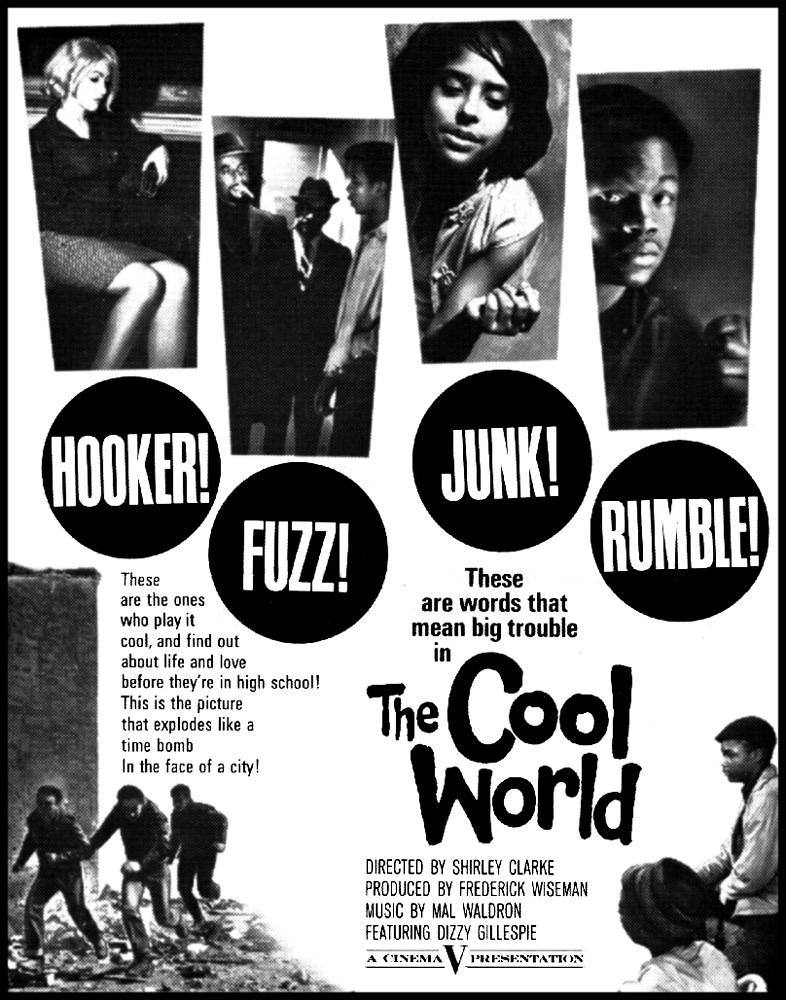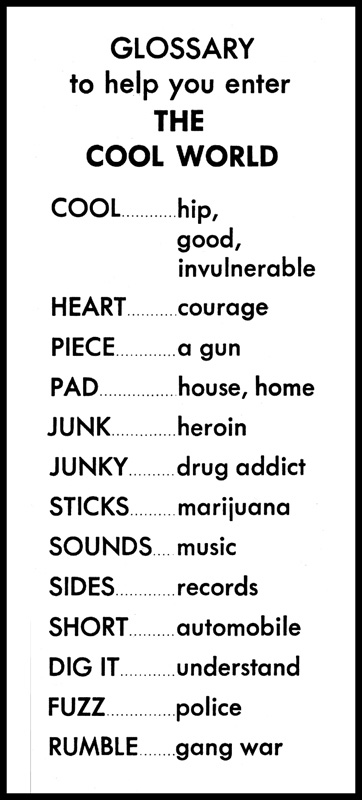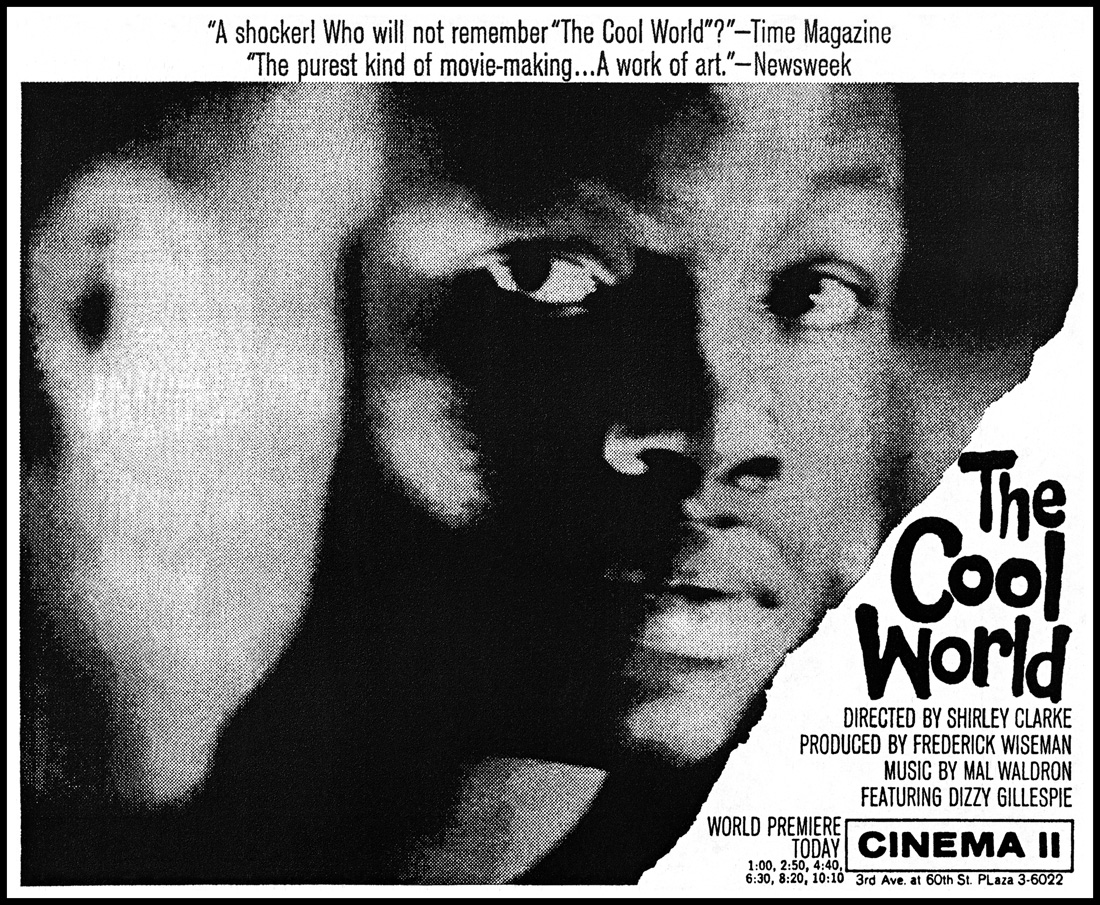|
THE COOL WORLD (1964).
 Back in the 1960s, the late Shirley Clarke was one of the pioneers of the US independent film scene, with such gritty efforts as THE CONNECTION and PORTRAIT OF JASON. Her second feature, THE COOL WORLD, had a healthy theatrical run during its initial release -- publicized as a critically-acclaimed art film for its Upper East Side premiere, and later as a gritty drugs-'n'-gangs melodrama when it made its way to 42nd Street's Lyric (in an odd way, they were both correct). Filmed on the mean streets of Harlem, this is a vibrant, joyous, ultimately caustic portrait of life in the ghetto, which utilizes a black-and-white, cinema-verité-style backdrop to spin its (even now) blunt tale... Avoiding the usual A-to-Z narrative, this bounces between the story of a young Black teenager's life, the daily routine of the surrounding characters, and the raw energy of city itself. Hampton Clanton (a.k.a. Rony Clanton, who'd later star in THE EDUCATION OF SONNY CARSON) stars as Richard "Duke" Curtis, a baby-faced kid who's also a member of a local gang, The Royal Pythons, and dreams of someday earning neighborhood respect by becoming a "cold killer." His first step is to earn enough money from selling loose joints (for a buck apiece) to buy a gun,
Back in the 1960s, the late Shirley Clarke was one of the pioneers of the US independent film scene, with such gritty efforts as THE CONNECTION and PORTRAIT OF JASON. Her second feature, THE COOL WORLD, had a healthy theatrical run during its initial release -- publicized as a critically-acclaimed art film for its Upper East Side premiere, and later as a gritty drugs-'n'-gangs melodrama when it made its way to 42nd Street's Lyric (in an odd way, they were both correct). Filmed on the mean streets of Harlem, this is a vibrant, joyous, ultimately caustic portrait of life in the ghetto, which utilizes a black-and-white, cinema-verité-style backdrop to spin its (even now) blunt tale... Avoiding the usual A-to-Z narrative, this bounces between the story of a young Black teenager's life, the daily routine of the surrounding characters, and the raw energy of city itself. Hampton Clanton (a.k.a. Rony Clanton, who'd later star in THE EDUCATION OF SONNY CARSON) stars as Richard "Duke" Curtis, a baby-faced kid who's also a member of a local gang, The Royal Pythons, and dreams of someday earning neighborhood respect by becoming a "cold killer." His first step is to earn enough money from selling loose joints (for a buck apiece) to buy a gun,  with his naive inner monologue obsessing about how cool his life will be once he's packing heat. Later, when a Python's father runs out on his kid, the club transforms the apartment into a makeshift gang-squat. In supporting roles, there's a pre-MOD SQUAD Clarence Williams III as a crazed junkie pimp named Blood. He provides their clubhouse with a teenage whore named Luanne (Yolanda Rodriguez), who puts out for the Pythons (for a small donation, of course). Plus there's Mel Stuart (ALL IN THE FAMILY's Henry Jefferson) as a con man. Of course, the minute Duke dips his wick into Luanne, he's smitten, with their first Harlem-hiatus (a now-nostalgic trip to Coney Island) jumpstarting the chaotic finale of gang violence, murder and abusive cops. In the end, THE COOL WORLD offers sympathy for its characters, yet never whitewashes its subject matter. Focusing on this gang mentality, it conveys their humanity -- as these teens do their best to survive amidst this everyday world of addicts, hookers, slums, broken families, and violence. Laced with legitimately hip dialogue (hence, the Glossary included in its press materials), for its day, this was provocative fare, told with a keen eye. Mal Waldron's jazzy score is excellent (with Dizzy Gillespie turning up for a curbside serenade), as is the overall sound design, which captures an aural tapestry of this time and place. Written by Clarke and Carl Lee (who plays Priest, a bad-ass pimp), the film rarely falters in its uncompromising drama. Steeped in urban truths, this helped lay the groundwork for the next 35 years of Black cinema, and while, arguably, Clarke's best and most accessible work, due to home-video-challenged producer Frederick Wiseman, it remains her least seen. with his naive inner monologue obsessing about how cool his life will be once he's packing heat. Later, when a Python's father runs out on his kid, the club transforms the apartment into a makeshift gang-squat. In supporting roles, there's a pre-MOD SQUAD Clarence Williams III as a crazed junkie pimp named Blood. He provides their clubhouse with a teenage whore named Luanne (Yolanda Rodriguez), who puts out for the Pythons (for a small donation, of course). Plus there's Mel Stuart (ALL IN THE FAMILY's Henry Jefferson) as a con man. Of course, the minute Duke dips his wick into Luanne, he's smitten, with their first Harlem-hiatus (a now-nostalgic trip to Coney Island) jumpstarting the chaotic finale of gang violence, murder and abusive cops. In the end, THE COOL WORLD offers sympathy for its characters, yet never whitewashes its subject matter. Focusing on this gang mentality, it conveys their humanity -- as these teens do their best to survive amidst this everyday world of addicts, hookers, slums, broken families, and violence. Laced with legitimately hip dialogue (hence, the Glossary included in its press materials), for its day, this was provocative fare, told with a keen eye. Mal Waldron's jazzy score is excellent (with Dizzy Gillespie turning up for a curbside serenade), as is the overall sound design, which captures an aural tapestry of this time and place. Written by Clarke and Carl Lee (who plays Priest, a bad-ass pimp), the film rarely falters in its uncompromising drama. Steeped in urban truths, this helped lay the groundwork for the next 35 years of Black cinema, and while, arguably, Clarke's best and most accessible work, due to home-video-challenged producer Frederick Wiseman, it remains her least seen.
© 1999 by Steven Puchalski.

|